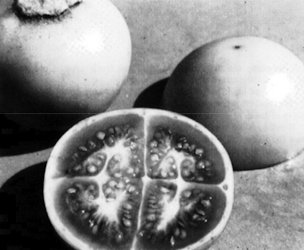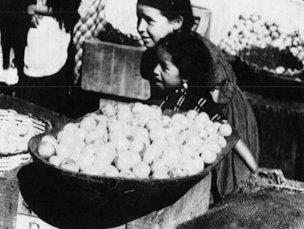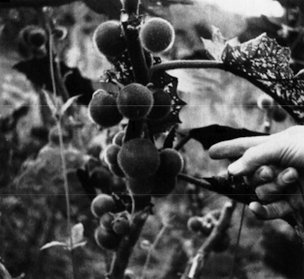Naranjilla (Lulo)
For centuries the naranjilla (Solanum quitoense)
has been an immensely popular fruit of Colombia and Ecuador. Writers
have described it as “the golden fruit of the Andes” and “the nectar of
the gods.”
Orange-yellow on the outside, 1 the fruits look somewhat
like tomatoes on the inside, but their pulp is green. Their juice,
considered the best in the region, is used to flavor drinks. 2 In fact, many even prefer it to orange juice.
Although
little known to the outside world, naranjilla (usually pronounced
na-ran-hee-ya in English) appears likely to produce a new taste for the
world's tables. It promises to become a new tropical flavor with a
potential at least as great as the increasingly popular passionfruit.
However,
producing naranjilla is a scientific challenge; before it can achieve
its potential, it needs intensive research. Despite its overwhelming
popularity in the northern Andes, it has been given little serious
commercial development. In fact, owing to several factors, naranjilla
fruits have become scarce and expensive in Ecuadorian and other Andean
markets. 3 Through misfortune and lack of funds, efforts to
check the devastation of nematode pests have failed so that production
in some areas is declining. On the other hand, demand is higher than
ever, owing to naranjilla's local popularity and the increasing export
of both fresh fruits and canned products.
Given attention, problems
such as these should be entirely avoidable, but even when such
operational difficulties are overcome, naranjilla will still be a
challenge to produce. It has little genetic diversity and,
consequently, is probably restricted to a narrow range of habitats. It
almost certainly requires a cool, moist environment—a type that is of
limited occurrence. It may also require a specialized pollinator.
Nonetheless,
with study, these problems can probably be overcome, or at least
mitigated. Then the taste of naranjilla should become known to millions.
PROSPECTS
The Andes.
Although now in decline, the naranjilla could become one of the major
horticultural products of the region and an important market crop for
small-scale producers. The fruit or juice (canned, frozen, or
concentrated) has considerable export potential. 4 What is needed is a coordinated effort to fully understand the crop's status and difficulties.
Nematocides
and biological controls are currently available to forestall the
devastation caused by root-knot nematodes. In addition, at least two
closely related species, apparently highly resistant to the root-knot
nematode, seem promising as rootstocks. They may also be sources of
genetic resistance, for they form fertile hybrids with naranjilla.
Other Developing Areas.
With the increasing international demand for exotic fruits, this is a
budding crop for the uplands of Central America and for other areas of
similar climate. Already, naranjilla has been established as a
small-scale crop in Panama, Costa Rica, and Guatemala. Both there and
in other frost-free, subtropical sites, it promises to become a
substantial resource. However, because of the plant's restrictive
climatic and agronomic requirements, success will not be achieved
easily. Establishing naranjilla in commercial production will require
much work and dedication.
Industrialized Regions.
Naranjilla can provide the basis for a new fruit- drink flavor that
could become popular in North America, Japan, Europe, and other such
areas. In a test at Cornell University several years ago, blindfolded
panelists unfamiliar with the fruit chose naranjilla juice over apple
juice by three to one, and a blend of naranjilla and apple juice over
apple juice alone by nine to one. In the 1970s, a major U.S. soup
manufacturer created a fruit drink based on naranjilla for nationwide
sale, but it reluctantly abandoned the project because of problems in
producing a large and reliable supply of fruit.
Pasto, Colombia. Naranjilla is among the most popular
fruits in the northern Andes.
USES
The naranjilla is versatile. It can be eaten raw or cooked
or used to make juice. It is also cooked in fruit pies and confections,
and is used to make jellies, jams, and other preserves. In Venezuela,
Panama, Costa Rica, and Guatemala, unstrained pulp is used for toppings
on cheesecakes, sponges, ice cream, yoghurt, and fruit salads. The
fresh juice is also processed into frozen concentrate and can be
fermented to make wine.
Despite its versatility, naranjilla is
mainly used at present to flavor drinks. In Ecuador and Colombia,
naranjilla sorbete is something of a national drink, often served in
hotels and restaurants. It is made like lemonade: the freshly extracted
juice is beaten with sugar into a foamy liquid that is green,
heavy-bodied, and sweet-sour in flavor. (Most tasters express surprise
that it is not a blend of several fruits.)
Naranjillas are eaten
only when fully ripe, at which time they yield to a soft squeeze and
their rather leathery skin is bright orange or yellow (though sometimes
still marbled with green). On average, they are about the size of golf
balls. The slightly acid flavor is more pronounced if the fruit is not
completely ripe. However, even some ripe fruits are too acid to be
eaten raw, and the pulp must be sweetened to be palatable.
Naranjilla fruit on a plant growing near Versailles,
Colombia.
NUTRITION
The naranjilla is rich in vitamins, proteins, and minerals. 5 It is said to contain pepsin, the stomach enzyme that aids digestion of proteins.
AGRONOMY
The
plant is propagated by seeds, cuttings, or grafts onto the rootstock of
other species. Seeds germinate freely. Cuttings root easily, especially
when parts of older, slightly woody stems are used. Like many members
of the Solanaceae, it can also be regenerated in tissue culture from
pieces of leaf or stem tissue.
The plant grows rapidly. Seedlings
begin bearing in 6–12 months; grafted plants mature even faster,
flowering at 3–4 months of age and maturing fruits at 6 months. In
principle, this perennial could continue bearing for years, but in the
Andes and Central America plantings usually succumb to root-knot
nematodes after about 4 years.
 | Naranjilla
fruits look something like tomatoes, but they have yellow skin and
green flesh. Their greenish juice provides one of the culinary delights
of Colombia,
Ecuador, and Venezuela. |
Naranjilla
is a “heavy feeder” and responds well to fertilization. Pruning old
woody stems at the end of a fruiting cycle results in vigorous regrowth
and prevents fruit size from diminishing.
Andean farmers mainly grow
naranjilla on rainy slopes, where, as long as temperatures remain
moderate, fruits are produced year-round. To prevent fungal and
bacterial root infections, well-drained soils are imperative. A common
practice is to plant naranjilla in openings in the forest or to
interplant it with banana, tamarillo, or achira. The taller plants help
protect the naranjilla's brittle branches from wind damage. 6
HARVESTING AND HANDLING
The
fruits are closely borne in the axils of the leaves on stems and
branches. They are easy to pull off by hand and are normally picked
when about half ripe —that is, when they have started to color. (They
subsequently ripen normally.) The stiff hairs can irritate the skin, so
the fruits are handled with gloves until ripe enough for the fuzz to be
wiped off with a towel.
The picked fruits have a shelf life of up to
two weeks without refrigeration, making naranjilla an ideal truck crop.
Cold storage lengthens the storage period considerably.
Yields are
high. Individual plants may produce up to 10 kg of fruit a year, and on
a per-hectare basis may yield 27 tons of fruit or 47,000 liters of
juice.
If not handled correctly, much of the flavor can be lost in
canning and the juice can turn muddy looking. Proper cooling, storage,
and the use of antioxidants are necessary.
LIMITATIONS
Naranjilla's
major problems have already been discussed. They are its climatic
restrictions and susceptibility to pests. More information is given
below.
Adaptability This
plant has received little attention from horticultural researchers; its
environmental adaptations, therefore, are not well known, but seem to
be narrow. It is possible that it needs a long growing season, as well
as high humidity. It cannot tolerate frost. Heat and dryness can also
cause crop failure.
Moreover, there are possible pollination
problems. Naranjilla appears to be a short-day plant; pollen abortion
occurs when days are long. 7 Pollinators may be absent in
locations outside its native range. The effects of shade and altitude
are also uncertain. The plant is said to perform poorly under 1,200 m
elevation in the Andes.
Pests and Diseases As noted, the plant is extremely susceptible to root-knot nematodes (Meloidogyne
species). Plantings often fail to reach full fruiting size as a result.
The naranjilla also suffers from insect pests; in particular, a wide
variety of coleopterans (beetles and weevils) chew the leaves.
The
plants can succumb to diseases such as bacterial wilt and fungal
infections. Root and stem rots can be particularly severe. Viruses,
too, can be troublesome.
RESEARCH NEEDS
Germplasm Collection Replicate germplasm collections should be established in Ecuador, Colombia, Peru, Costa Rica, and other countries.
A
germplasm collection of 185 samples is already being evaluated at the
Instituto Colombiano Agropecuario (ICA) in Colombia. 8
Nematodes
The nematode problem is the major one to be addressed. As a starter,
nematologists should determine the varieties of the offending pests.
Also, the relation between nematode resistance and temperature should
be checked. (Recent research has shown that nematode-resistant tomatoes
become susceptible as temperature rises.)
Although nematode-killing
chemicals can be used to treat the soil, these tend to
be toxic and expensive. An alternative approach could be biological
control. 9 Screening for strains resistant to nematodes
(and viruses) seems promising as well, although development of
horticulturally viable types could take years.
Alternative approaches include the following:
• Hybridizing naranjilla with closely related, nematode-resistant species. Hybrids with Solanum hirtum and S. macranthum,
for example, have good nematode resistance. Backcrossing these to
naranjilla has produced a range of plants that have shown resistance
and have borne fairly good fruit. 10
• Grafting naranjilla on related plants with nematode-resistant rootstock.
When cleft grafted on species such as S. macranthum and S. mammosum,
naranjilla plants have survived for about three years and fruited
successfully. In tropical Africa, naranjilla has done well when grafted
to its nematode-resistant local relative, S. torum. 11
• Improving plant vigor by better management.
• Producing the crop in beds of sterilized soil.
•
Growing a cover crop or rotation crop of plants, such as velvet bean or
Indigofera species, that help eliminate nematode infestations.
• Inducing somaclonal variation in regenerated plants as a way of unmasking inherent nematode resistance that is now hidden.
•
Educating farmers about nematodes and the means of keeping sites free
of infestation. (This is important, whatever other approach may be
used.)
SPECIES INFORMATION
Botanical Name Solanum quitoense Lamarck
Family Solanaceae (nightshade family)
Synonyms Solanum hirsutissimum; Solanum angulatum
Common Names
Quechua: lulo, lulu puscolulu
Spanish: naranjilla, naranjillo; naranjilla de Quito, naranjita, lulo, lullo, toronja, tomate chileno (Peru)
English: Quito orange, naranjilla, lulo
French: naranjille, morelle de Quito, orange de Quito
German: Lulo-Frucht
Origin.
Naranjilla's origin is unknown. Its wild progenitor may yet be
discovered—probably in Colombia. It is thought that the plant was
domesticated within the last few hundred years, because there is no
evidence that it was cultivated in pre-Columbian times. The first
records of naranjilla cultivation are from the mid–1600s in Ecuador and
Colombia. Traditionally, areas of major cultivation have been the
valleys of Pastaza and Yunguillas in Ecuador and the mountain areas of
Cauca and Nariño in Colombia.
Description.
The plant is a perennial, herbaceous shrub, 1–1.5 m high, with stout,
spreading, brittle stems. Its dark-green, purple or white-veined
leaves are often more than 30 cm long and, like the stems, are densely
pubescent. The pale lilac flowers are covered with a thick “felt” of
light-purple hairs.
The spherical, yellow-orange fruit is 3–8 cm in
diameter. It has a leathery skin, densely covered with fine, brittle,
easily removed, white to brown hairs. Internally, its structure
resembles a tomato. The acidulous, yellow-green flesh contains a
greenish pulp with numerous seeds and green-colored juice.
Horticultural Varieties.
On the whole, the species is unusually uniform for a cultivated plant.
However, two geographically separated varieties are recognized. Variety
quitoense is the common, spineless form found in southern Colombia and Ecuador. Variety septentrionale has spines, is hardier, and grows mainly at altitudes of 1,000–1,900 m in central Colombia and Costa Rica.
In
the last few years, an apparently new variety has appeared in Quito
markets. Although the fruits are smaller than normal, they are rapidly
becoming the dominant commercial type. 12 Investigation of
this may help open a new era in naranjilla use. Is this a new hybrid?
Is it being grown because of greater nematode resistance? Or is the
fact that its fruits have few hairs the driving force behind its
production?
Environmental Requirements
Daylength.
As noted, the plant seems to require short days for pollination.
However, this is not certain because satisfactory fruit set has been
noted in south Florida at any time of year. 13
Rainfall.
Naranjilla requires considerable moisture. It is commercially grown in
the Andean areas where annual rainfall is 1,500–3,750 mm. The lower
moisture limits are uncertain, but even moderately dry conditions check
its growth.
Altitude. This
is not a restriction. Samples have been collected near 2,000 m
elevation in Ecuador, and the plant grows near sea level in New Zealand
and California.
Low Temperature. Below 10°C the plant's growth is severely checked. It is frost sensitive.
High Temperature.
Above 30°C the plant grows poorly. It does not set fruit in areas with
high night temperature—a possible reason why it has failed in some
lowland tropical and subtropical areas.
Soil Type.
In Ecuador, the naranjilla grows best on fertile, well-drained slopes.
It requires soils that hold moisture but that drain well enough to
avoid waterlogging. It seems particularly sensitive to salt. 14
Related Species.
Naranjilla has several relatives that produce desirable fruits and
deserve more attention. They could be useful in their own right as well
as perhaps for genetically improving naranjilla. 15
Solanum pectinatum
This plant, although undomesticated, produces high quality fruits,
almost as good as those of the naranjilla. Compared with the
naranjilla, the fruits are slightly smaller, but their hairs rub off
more readily, and they taste somewhat sweeter. This is a lowland
species, widely distributed from Peru to southern Mexico, and from sea
level to 1500 m. Throughout the region, people gather the wild fruits
for making juice. It, too, deserves wider appreciation; a little
horticultural investigation might produce a new crop as popular as the
naranjilla, but suitable for cultivation in areas too warm for
naranjilla.
Solanum vestissimum
Native to Colombia and Venezuela, this is another wild species with
pleasantly flavored fruits. It grows at higher altitudes than
naranjilla. Known as “lulo de la tierra fria” (naranjilla of the cold
lands), toronja, or tumo, it is a small tree that bears fruit about the
size of duck eggs. The chief objection is that the fruit's hairs are
quite bristly and the juice is difficult to extract. For all that,
however, it has an excellent flavor and deserves research attention.
1
Although “naranjilla” is Spanish for “little orange,” the fruit is not
a citrus, but is a relative of the tomato and potato. In many areas it
is called “lulo,” a pre-Columbian word, possibly of Quechua origin.
2
In the 1760s, the Majorcan missionary Juan de Santa Gertrudis Serra
wrote of the naranjilla: The fruit is very fresh [and diluted] in
water with sugar, makes a refreshing drink of which I may say that it
is the most delicious that I have tasted in the world.
3 In the last decade, prices have increased more than tenfold (even accounting for inflation).
4 Colombia is already exporting small amounts to Central America and the United States.
5
The composition per 100 g edible portion: calories, 23; water, 92.5 g;
protein, 0.6 g; fat, 0.1 g; carbohydrates, 5.7 g; fiber, 0.3 g; ash,
0.8 g; calcium, 8 mg; phosphorus, 12 mg; vitamin A, 600 Int. units;
thiamine, 0.04 mg; riboflavin, 0.04 mg; niacin, 1.5 mg; ascorbic acid,
25 mg. Information from J. Morton.
6 It has been
suggested that on a commercial scale, the naranjilla could be
interplanted between babaco, mandarin orange, passionfruit (on wire
lattices), or other crop with the naranjilla's climatic requirements.
Suggestion from D. Endt.
7 Information from J. Soria.
8 Information from L.E. Lopez J.
9 For example, the bacterium Pasteuria penetrans
has proved as effective as current nematocides on other crops in
Britain. Spores can be produced in vivo on nematodes in roots, without
the necessity of sterile production systems. Information from B.R.
Kerry.
10 Information from L.E. Lopez J.
11
Both hybridizing and grafting also bestow resistance to root and collar
rot. However, further evaluation is needed to ensure that alkaloids in
the fruits do not rise to hazardous levels. Information from J. Soria.
12 Information from L.E. Lopez J.
13 Information from J. Morton.
14 Information from L. Davidson.
15 Information in this section is mainly from C. Heiser.
|


